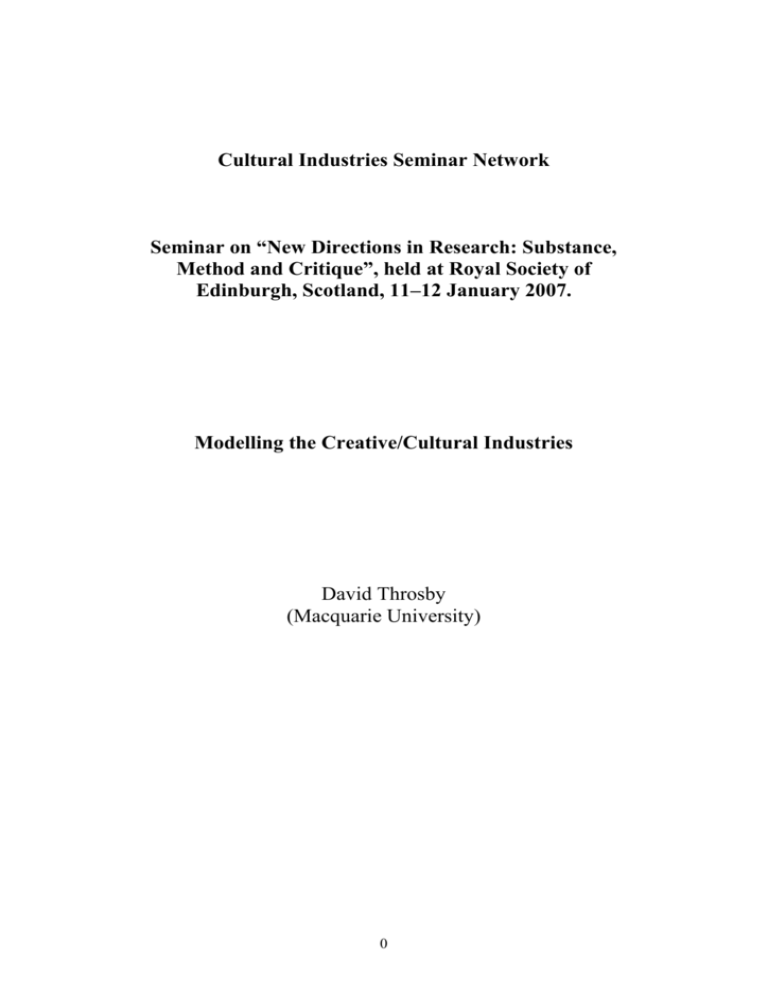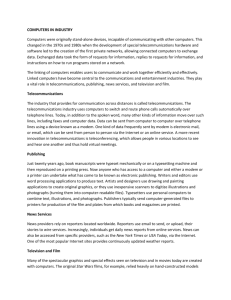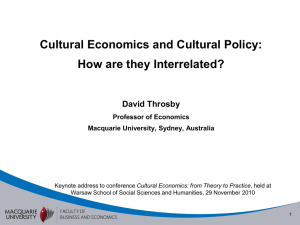Modelling the Creative/Cultural Industries
advertisement

Cultural Industries Seminar Network Seminar on “New Directions in Research: Substance, Method and Critique”, held at Royal Society of Edinburgh, Scotland, 11–12 January 2007. Modelling the Creative/Cultural Industries David Throsby (Macquarie University) 0 Outline 1. Introduction 2. Some models of the creative/cultural industries DCMS model Symbolic texts model Concentric circles model WIPO copyright model UIS trade-related model Americans for the Arts model 3. Can a set of “core” creative/cultural industries be identified? 4. New research directions: an economist’s perspective 5. Macroeconomic analysis Microeconomic analysis Labour economics International trade Law and economics Locational economics Economic development Cultural policy Conclusions 1 Some models of the creative/cultural industries 1. DCMS model (UK Department of Culture, Media and Sport, The Creative Industries Mapping Document 2001, London: DCMS, 2001). Based on activities requiring creativity, skill and talent, with potential for wealth and job creation through exploitation of their intellectual property. 2. Symbolic texts model (David Hesmondhalgh, The Cultural Industries, London: Sage, 2002). Based on industries concerned with industrial production and dissemination of symbolic texts. 3. Concentric circles model (David Throsby, Economics and Culture, Cambridge: Cambridge University Press, 2001). Based on origin and diffusion of creative ideas in sound, text and image from core creative arts. 4. WIPO copyright model (World Intellectual Property Organisation, Guide on Surveying the Economic Contribution of the Copyright-based Industries, Geneva: WIPO, 2003). Based on industries involved directly or indirectly in the creation, manufacture, production, broadcast and distribution of copyrighted works. 5. UIS trade-related model (UNESCO Institute for Statistics, International Flows of Selected Cultural Goods and Services 1994–2003: Defining and Capturing the Flows of Global Cultural Trade, Montreal: UIS, 2005). Based on cultural goods and services entering international trade. 6. Americans for the Arts model (Americans for the Arts, Creative Industries 2005: The Congressional Report, Washington DC: Americans for the Arts, 2005). Based on businesses involved with the production or distribution of the arts (“arts-centric businesses”). 2 Models of the creative/cultural industries: classification systems 1. DCMS Model 2. Symbolic Texts Model 3. Concentric Circles Model Advertising Architecture Art and antiques market Crafts Design Fashion Film and video Music Performing arts Publishing Software Television and radio Video and computer games Core cultural industries Advertising Film Internet Music Publishing Television and radio Video and computer games Core creative arts Literature Music Performing arts Visual arts Peripheral cultural industries Creative arts Borderline cultural industries Consumer electronics Fashion Software Sport Other core cultural industries Film Museums and libraries Wider cultural industries Heritage services Publishing Sound recording Television and radio Video and computer games Related industries Advertising Architecture Design Fashion 3 Models of the creative/cultural industries: classification systems (cont.) 4. WIPO Copyright Model 5. UIS Trade-related Model 6. Americans for the Arts Model Core copyright industries Advertising Collecting societies Film and video Music Performing arts Publishing Software Television and radio Visual and graphic art Core cultural goods and services Audiovisual services Books Copyright royalties Heritage Newspapers, periodicals Recordings Video games Visual arts Advertising Architecture Arts schools and services Design Film Museums, zoos Music Performing arts Publishing Television and radio Visual arts Interdependent copyright industries Blank recording material Consumer electronics Musical instruments Paper Photocopiers, photographic equipment Related cultural goods and services Advertising Architectural services Audiovisual equipment Information services Musical instruments Partial copyright industries Architecture Clothing, footwear Design Fashion Household goods Toys 4 Quantifying the concentric circles model: creative occupations as a proportion of total employment in each industry group: UK, US, Australia, New Zealand, Canada (2001, %) Industry group UK US AUS NZ CAN Core Creative Arts 41.7 42.5 65.5 53.9 46.6 Other Core Creative Industries 13.7 21.2 17.3 17.2 25.9 Wider Cultural Industries 4.3 6.9 9.4 5.4 5.7 Related Industries 1.7 2.1 1.4 2.0 0.9 Non-cultural Industries 0.6 0.1 0.4 0.5 0.2 5 Three models compared: industries included in broad classification Creative/cultural industries: broad classification Symbolic texts model (a) Concentric circles model (b) WIPO copyright model (c) X X X Architecture X X Design X X Advertising Fashion X X Film, video X X Hardware (d) X Heritage services X X X Literature X X X Music X X X X X X X Museums, galleries, libraries Publishing, print media X Software X Sport X Theatre, dance X X X Television, radio, broadcast media X X X Video games X X X Visual art, craft, photography X X X X Notes: (a) including “core”, “peripheral”, and “borderline” cultural industries. (b) including “core creative arts”, “other core cultural industries”, “wider cultural industries” and “related cultural industries”. (c) including “core copyright”, “interdependent copyright” and “partial copyright” industries. (d) including audiovisual and photographic equipment, musical instruments, etc. 6 Three models compared: industries included in “core” Creative/cultural industries: “core” classification Symbolic texts Concentric circles model model Advertising X WIPO copyright model X Architecture Design Fashion Film, video X X X X X X X Hardware Heritage services Literature Music X Museums, galleries, libraries Publishing, print media X X X Software X Sport Theatre, dance X X Television, radio, broadcast media X X Video games X X Visual art, craft, photography X 7 X Research directions in the economics of the cultural industries 1. Macroeconomics interindustry relationships: interaction between cultural and other industries in the economy and the diffusion of creative ideas: how does it happen? cultural industries as dynamic sector in structural transformation: how significant are they? political economy issues: corporate power, cultural impacts of globalisation 2. Microeconomics value chain/value networks in cultural production role of creativity as an input in production processes emerging trends in consumption: consumers as co-creators? 3. Labour economics earnings functions, labour supply functions, labour market participation creative workers as a highly skilled, mobile, project-based labour force career pathways in cultural production; entry/exit decisions; the role of risk 4. International economics agreement on definitions of cultural goods and services in trade role of cultural goods in multilateral and bilateral trade negotiations role of cultural diversity in international relations 5. Law and economics copyright in the digital age freedom of expression, moral rights contract theory and cultural production 6. Locational economics reality of network effects: how important are agglomeration externalities? cultural industries and regional growth: effects on employment, inward investment, tourism, etc. cultural industries in urban livability 7. Economic development structure of cultural industries in developing countries role of cultural industries in meeting Millennium Development Goals sustainability: linking economic and cultural development 8. Cultural policy relationships between economic and cultural policy value creation as a policy objective institutional design and the pursuit of cultural policy 8









